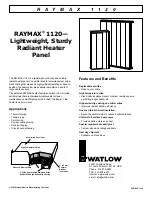
UNT-SVX26E-XX
Potenza nominale installata /
Nominal installed power
Puissance nominale installée / Installierte Nennleistung
Potencia nominal instalada
/ Nominaal geïnstalleerd vermogen
230V ~
Corrente assorbita max. /
Current input
Courant absorbé / Max. Stromaufnahme
Máxima corriente absorbida
/ Max. opgenomen vermogen
Fusibile consigliato (Tipo gG) per la protezione da sovraccarico
Recommended fuse (Typo gG) for overload protection
Fusible conseillé (Type gG) pour la protection de surcharge
Zum Schutz vor Überlastung empfohlene Sicherung (Typ gG)
Fusible aconsejado (Tipo gG) para la protección contra la sobrecarga
Aanbevolen zekering (Type gG) ter bescherming tegen overbelasting
400
Watt
600
Watt
1000
Watt
600
Watt
900
Watt
1500
Watt
2,0 A
2,8 A
4,5 A
2,8 A
4,0 A
6,7 A
4 A
4 A
6 A
4 A
6 A
8 A
C
ASING
2
3
33
BATTERIA
ELETTRICA
Per le configurazioni 2 tubi (freddo)
con resistenza elettrica, cablando il termostato a bordo,
i conduttori dedicati ad attuatore
e relay di attivazione resistenza devono essere cablati
come di seguito rappresentato.
For the configurations 2 pipes cooling
with electric heater, in case of accessories thermostat
to be mounted on the unit, the valve actuator
and electric heater relay must be wired as below.
Pour les systèmes à 2 tubes (froid)
avec la résistance électrique, de câbler le thermostat
à bord, le câblage de l'actionneur et du relais
de la résistance doit être effectuée comme suit.
Für 2-Rohr-Systeme (kalt)
mit dem elektrischen Widerstand, den Thermostat an Bord
zu verdrahten, die Verdrahtung des Relais-Antrieb
und Widerstand sollte wie folgt durchgeführt werden.
Para sistemas de 2 tubos (frío)
con la resistencia eléctrica, para conectar el termostato
a bordo, el cableado del actuador y del relé
de la resistencia se debe realizar de la siguiente manera.
Voor 2-pijps systemen (koud)
met de elektrische weerstand, om de thermostaat
aan boord van draad, bedrading van de aandrijving
en relais weerstand moet als volgt worden uitgevoerd.
ELECTRIC
RESISTANCE
Le unità possono essere fornite con
resistenza elettrica (del tipo monofase
alimentazione 230Vac, costruzione
alluminio alettato) installata e cablata
direttamente in fabbrica.
La configurazione prodotto, con resi-
stenza elettrica, prevede l’impiego di
n° 2 termostati di sicurezza atti a limi-
tare sovratemperature interne all’ap-
parecchio stesso.
Il termostato di primo intervento è del
tipo a riarmo automatico (pertanto
auto ripristinabile cessato il fenomeno
di guasto), mentre il termostato di se-
condo intervento è del tipo a riarmo
manuale (posizione dell’organo di ri-
pristino come da immagine che segue).
In caso di intervento della protezione
a riarmo manuale occorrerà ripristi-
nare il sistema solo dopo aver tolto
tensione ed aver accertato la causa
di guasto (intervento da effettuarsi
esclusivamente da personale prepo-
sto alla manutenzione).
Si raccomanda di non ostruire il flusso
d’aria e di controllare l’efficienza del
filtro aria con cadenza settimanale.
L’alimentazione della resistenza elet-
trica deve essere separata da quella
prevista per la parte moto ventilante e
provvista di propria messa a terra (PE).
Raccomandato altresì l’impiego di un
interruttore atto a garantire una discon-
nessione onnipolare con distanza
minima di separazione tra i contatti
pari a 3.5mm.
Per le unità con resistenza elettrica
abbinate con comandi a parete occor-
rerà effettuare il collegamento elettrico
come da impostazione impianto a 4
tubi dove, in luogo dell’attuatore val-
vola-caldo, verrà collegato il segnale
di fase per l’attivazione della resisten-
za elettrica. Per siffatta metodologia di
collegamento la ventilazione è continua
con termostatazione su attuatore val-
vola-freddo e resistenza elettrica.
Detti comandi possono gestire un solo
ventilconvettore. Per il controllo di più
ventilconvettori, con unico comando,
è necessario che ogni apparecchio sia
corredato di un selettore di velocità REL
che, su segnale del comando remoto,
azionerà il proprio apparecchio.
The units can be supplied with an
electric heating element (230Vac single-
phase, finned aluminium structure)
fitted and wired directly in the factory.
The configuration of the product with
the electric heating element is intended
to be used with 2 safety thermostats
which limit the internal over temperature
of the unit.
The first intervention thermostat has
automatic rearming (and therefore is
reset automatically as soon as the fault
has ended), whereas the second
intervention thermostat has manual
rearming (the position of the reset
device is as shown in the figure).
In the event the manual rearm protective
device intervenes, the system will need
to be restored only after having cut
power and found out the cause of the fault
(intervention reserved for maintenance
operators alone).
It is recommended not to obstruct the
air flow and to check the efficiency of
the air filter once a week.
The electric heating element must be
powered separately from the fan motor
and must be provided with its own
earthing (PE).
It is also recommended to use a switch
providing an omnipolar disconnection
with a minimum separation distance
between the contacts of 3.5mm.
For the units with heating elements
coupled with wall-mounted controls,
an electrical connection will need to
be performed as for the 4-pipe system
where, in place of the valve actuator-
heat, the phase signal will be connected
for activation of the electric heating
element. In this type of connection,
ventilation is continuous with thermostat
control on the valve actuator-cold and
electric heating element.
These controls can manage only one
fan coil. In order to manage more than
one fan coil with one sole control, each
appliance must be equipped with a REL
speed selector which, upon receiving
a remote control signal, activates its
own appliance.
Содержание FCAE
Страница 86: ...NOTES UNT SVX26E XX ...
Страница 87: ...NOTES UNT SVX26E XX ...
















































